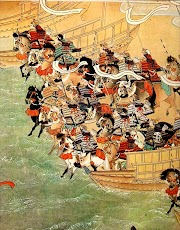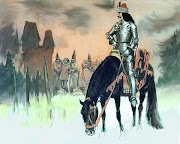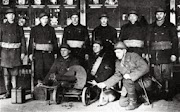Based on The Willing Flesh by Willi Heinrich (1955).
Reviewed by: Ben Sparks, Worcester State University 2012
Reviewed by: Ben Sparks, Worcester State University 2012
Famed 1960’s and 1970’s director Sam Peckinpah’s, Cross of Iron, is a gritty, dark, violent, and yet highly stylized and analytical film, detailing the daily struggles and dangers faced by Wehrmacht soldiers stationed on the Eastern Front during World War II from 1943-1945. In particular the audience experiences the deeds of anti-hero Sergeant Rolf Steiner, played by James Coburn, and his ragtag platoon during their deployment in Russian at the Kuban bridgehead in 1943.
The title of the film comes from the other lead, Captain Stransky, played by Maximilian Schell who is an ambitious aristocrat of the Prussian officer corps. He sought transfer to the Eastern Front in order to win the Iron Cross. This “heroic horses ass” as he calls himself in jest, helps to carry much of the later plot of the film in which Sgt. Steiner and his platoon must fight their way back to their own lines, in a last ditch effort to survive the war in 1944-1945 after they are double-crossed by the scheming and cowardly officers who command them. The audience is introduced to Sgt. Steiner and his rather unorthodox command after the opening credits as we witness their deadly efficiency in dispatching several Red Army soldiers in an advance position during a reconnaissance mission.
Of dubious origins, Steiner’s platoon is comprised of a bunch of rough and battle-hardened veterans who have seemingly grown very disillusioned with their mission in Russia. Regardless they still continue to fight the advancing Red Army out of their own instincts for survival and out of a sense of duty to their comrades. This coupled with the sentiment echoed through the prophetic and highly poetic dialogue between Stransky and the other veteran officers who greet him upon his arrival in Russia gives Cross of Iron a fairly obvious and very relevant anti-war, post-Vietnam feel, that manages to say something about the human condition during battle without becoming overt propaganda for or against the two sides involved in this particular war. Peckinpah chooses throughout the film to highlight not just the violence and carnage associated with the stories background but the camaraderie, friendship, platonic and potential for homosexual love between the German soldiers, and the fear of impending death that hangs over all of them during their tour of duty. Through Sgt. Steiner we see not just the tough as nails commander who is without fear even in the face of overwhelming odds, but a solider who is caught between what he feels is just and the Prussian officer corps who adhered to the unrealistic Nazi-German military code of honor, which demanded that they die.
Besides the very heavy undertones of religious, spiritual, and philosophical thought behind the Wehrmacht soldier’s exchanges and soliloquies, this film works well because it realistically portrays the scenery and backdrop of this historical setting. Cross of Iron utilizes rather large set-piece battles to show the professional worth and courage of the German soldier ultimately falling to the large material and manpower pools of the Red Army. The two major battles, at the beginning and the very end of the film seem to use hundreds of extras to really bring these fictionalized battles to life with some impressive technical thrills.
T-34 tanks and Soviet era planes are used realistically throughout the film and to great effect cinematically, especially in the climax of the film. For those who are interested in firearms and weapons of the 20th century there is a truly diverse amount of rifles, pistols, machine guns, mortars, and knifes on display in Cross of Iron. From German MP40’s, tripod mounted MG42’s, Luger and Walther automatic pistols, to Sgt. Steiner’s personal favorite, a commandeered Red Army PPSh-41 submachine gun, there are many varying weapons seen throughout the two hours run time.
The violence throughout Cross of Iron, though frequent and stark may seem somewhat campy by today’s standards of drama and seem chintzy compared to developments in film technology, but it still stands out as a more gritty and poignant interpretation, as opposed to the more action-adventure style World War II films of the 60’s and 70’s, such as the Dirty Dozen or Kelly’s Heroes. It’s certainly aggressive in portraying an accurate and deeply compelling saga of the German enlisted man who fought on the Eastern Front though the age of this film shows in the frequent use of rather abstract and surreal flashbacks, pertaining to Steiner’s wartime experiences and traumas after his first deployment in Russia. Regardless this film holds up to the test of time as a worthwhile and entertaining, engrossing, complex artistic interpretation of the Second World War. Overall Cross of Iron is a noteworthy English language dramatic look at the not so often dramatized first hand experience of the German soldier during the Nazi-Soviet War.
The violence throughout Cross of Iron, though frequent and stark may seem somewhat campy by today’s standards of drama and seem chintzy compared to developments in film technology, but it still stands out as a more gritty and poignant interpretation, as opposed to the more action-adventure style World War II films of the 60’s and 70’s, such as the Dirty Dozen or Kelly’s Heroes. It’s certainly aggressive in portraying an accurate and deeply compelling saga of the German enlisted man who fought on the Eastern Front though the age of this film shows in the frequent use of rather abstract and surreal flashbacks, pertaining to Steiner’s wartime experiences and traumas after his first deployment in Russia. Regardless this film holds up to the test of time as a worthwhile and entertaining, engrossing, complex artistic interpretation of the Second World War. Overall Cross of Iron is a noteworthy English language dramatic look at the not so often dramatized first hand experience of the German soldier during the Nazi-Soviet War.







